Varieties of roses with colorful flowers
We never cease to admire the queen of the garden, the rose, when it is monochromatic. But two-color varieties of roses will not leave anyone indifferent. Bicolor and variegated roses are hybrid varieties that have the characteristics and characteristics of several varieties.The shades of two-color roses can be surprisingly whimsical and spectacular; it is sometimes difficult to express them in words. For lovers of bright and unusual flowers, we invite you to read the description of the best two-color and variegated roses with photos and names.
| Content:
|
|
These roses combine a variety of colors and shades in the most amazing way. |
Two-color varieties of hybrid tea roses
Hybrid tea roses appeared in 1867 as a hybrid of tea and remontant roses. All representatives of this group form impeccable flowers that tend to bloom continuously.
Chicago Peace
|
Chicago Peace is one of the best bicolor varieties with large flowers. |
The Chicago Peace rose variety was created by American breeders in 1962. Looks equally good both in cutting and in group plantings in flower beds.
- The bush is large, 1.2-1.5 m in height, 0.8 m in width. The stems are long, with dark green glossy foliage.
- The flowers are large, 13–15 cm, goblet-shaped, consist of 40-60 petals, and have a light aroma. At the same time, up to 7-8 buds bloom on the bush. The petals are coral pink, a color with a pale yellow tint at the base. The color of the buds depends on the growing conditions of the roses and the conditions for caring for them.
- Flowering lasts from June to September in waves.
- The effect of rain on flowering is negative; flowers do not bloom. There is a high probability of contracting fungus and mold.
- Resistance to pest diseases is average. The variety is easily affected by black spot.
- In the sun, with prolonged heat, the flowers fade to a creamy shade.
- Frost resistance corresponds to zone 6 (from -23°C to -18°C), requires shelter.
Double Delight
|
The name of this rose translates as “double pleasure.” But everyone decides for themselves what it is: in the contrast of the color of the petals or in the combination of color and pleasant aroma. |
The variety was developed in the USA in 1976. The color intensity of this hybrid tea rose depends on the weather - the hotter it is, the brighter it is.
- The bush is tall, 0.9-1.5 m, spreading, with a diameter of 0.6-1.5 m. The shoots are abundantly covered with dense dark green leaves.
- The flowers are large, on average 14 cm, double. The bud has a classic goblet shape and blooms slowly. The color of the petals is notable for the white or cream center and bright crimson edges of the outer petals. The bud contains up to 45 petals. The aroma is strong, with fruity notes.
- Flowering begins in June and repeats in August.
- Rain resistance is poor. In rainy weather the buds do not open. Excessively wet weather provokes fungal disease.
- Disease resistance is average. Double Delight is especially susceptible to powdery mildew.
- Doesn't fade in the sun.
- Frost resistance corresponds to zone 6 (from -23°C to -18°C), shelter for the winter is required.
Orient Express (Pullman Orient Express)
|
The Orient Express rose will decorate any flower garden and retains freshness for a long time when cut. |
American variety, bred in 2001. It has a number of advantages: high immunity, drought, heat, frost resistance, and most importantly, charming large multi-colored flowers.
- Tall bushes, 1.5-2.0 m, covered with large dark green glossy foliage.
- The flowers are large, 13–15 cm, densely double. The classic cup-shaped buds slowly open, with the edges of the petals turning outward. The petals are creamy yellow with red strokes along the edges.The flowers are enveloped in a light aroma.
- Flowering begins in June and repeats until September.
- Resistance to rain and hail is weak. In rainy weather the flowers do not open.
- Resistance to fungal diseases is high.
- Doesn't fade in the sun.
- Frost resistance corresponds to zone 6 (from -23°C to -18°C), shelter for the winter is required.
Gloria Dei
|
The Gloria Day variety is considered the standard of hybrid tea roses. Resistant to low temperatures and diseases. |
One of the favorite and popular varieties. Launched in France in 1945. Suitable for single and group plantings in mixborders, on the lawn, for standard crops and for cutting.
- The bush is powerful, up to 1.2 m high, strewn with large shiny foliage. The stems are thick, straight, practically without thorns. The leaves are dark green, dense.
- The flowers are large, 13-16 cm, double. Placed singly or in 2-3 pieces. The buds take a long time to bloom. The color of the flowers varies depending on the weather and location - from bright yellow to creamy cream with pinkish edges. It has an aroma whose intensity is constantly changing.
- Repeated flowering from mid-June to September.
- Resistance to rain is average, flowers are partially damaged.
- Resistance to pests and diseases is high.
- In the sun the color fades and becomes creamy pink.
- Frost resistance corresponds to zone 6 (from -23°C to -18°C), shelter for the winter is required.
Ambiance
|
The highlight of the variety is the slow blooming of the buds, which allows you to enjoy the beauty of the flowers for a long time. |
A characteristic feature of this two-colored French variety, bred in 1998, is the slight thorniness of the shoots. This makes it easier to care for and cut flowers. Used for cutting, for single and group plantings.
- Shrub up to 1.2 m high with shiny dense leaves. The diameter of the rose bush is about 70-80 cm.
- The flowers are double, up to 10 cm in diameter, consisting of 35-40 petals. The shape of the flowers is goblet. Up to 3 buds are formed on each stem. The petals have a double color: bright yellow with a red border. The color depends on the place of growth and weather conditions. The blossoming buds emit a light, sweet aroma. The flowers stay on the bush for quite a long time.
- Flowering is continuous, from June to September.
- Resistance to rain is good, the buds do not deteriorate from water.
- Resistance to black spot is high, but low to powdery mildew.
- Doesn't fade in the sun.
- Frost resistance corresponds to zone 6 (from -23°C to -18°C), shelter for the winter is required.
Caribbean
|
The unusual, variegated colors of the flowers are a godsend for rose lovers. Each flower is unique and unique. . |
This exotic variety was created in the UK in 1972. Caribbean is suitable for group plantings and cutting.
- Bushes up to 1.1 m high, 0.6 m wide. Leaves are dark green.
- The flowers are double, large, up to 10 cm in diameter. The petals are orange-salmon with stripes and strokes of yellow. The aroma is light strawberry-citrus.
- Rain resistance is good. The flowers can withstand rain well.
- Disease resistance is average, the crop is affected by black spot.
- Doesn't fade in the sun.
- Frost resistance corresponds to zone 5 (-29 ° C).
Blush
|
Rose Blush is a rare and unusually beautiful variety due to its petals changing color when the bud opens. |
A hardy plant that tolerates heat and severe frosts well. The two-color variety was created in 2007 in the USA. Cut buds retain freshness for a long time.
- Bush 1.2 m high with long, thornless shoots.The leaves are dark green, glossy.
- The flowers are densely double, soft pink inside, bright crimson at the edges, goblet-shaped. The flowers are 10-12 cm in diameter, without fragrance.
- Rain resistance is average.
- Disease resistance is average, prevention is required.
- Doesn't fade in the sun.
- Frost resistance corresponds to zone 6 (from -23°C to -18°C), shelter for the winter is required.
Two-color varieties of climbing roses
Climbing roses include types of rose hips, as well as several varieties of garden roses that branch with long stems. They belong to the rosehip genus. This culture is very popular in vertical gardening of various buildings, arches, walls, gazebos.
Louis Pajotin
|
A rare climbing variety of Louis Pajotin roses, bred from a hybrid tea rose of the same name. |
Launched in 1959. Easy to care for, frost-resistant and very decorative. Beauty can be assessed from a photo.
- The bush grows up to 2 m in height and up to 1 m in width.
- The flowers are large, 9–12 cm, double. The buds bloom in large clusters. The petals are pink with a scarlet or salmon tint, with a creamy reverse side. Flowers constantly change their color; no two flowers are the same. The aroma is delicate and pleasant.
- Blooms abundantly until late autumn.
- Rain resistance is average.
- Average resistance to powdery mildew and black spot; preventative treatment is indispensable.
- Preserves the color of petals in the sun.
- Frost resistance corresponds to zone 6 (from -23°C to -18°C), shelter for the winter is required.
Do not miss:
Jasmina
|
Rose Jasmina is a godsend for gardeners who dream of a lush climbing and very fragrant variety. |
High decorative qualities allow the rose to be planted singly or used in group compositions.
- The length of the shoots reaches 2.5 m in height, the bush grows up to 1 m in width. The shoots branch well, the foliage is semi-glossy, bright, dense.
- The flowers are densely double, surprisingly lush, containing up to 75 petals. Collected in brushes of 10-15 pieces. The diameter of the flowers is 9-11 cm. The petals in the center are bright pink, but the outer ones are almost white. One more advantage of this variety should be described - an amazing aroma that intensifies in the evening. Notes of apple predominate, but the aroma of both pear and apricot is felt.
- Re-blooming type of flowering, from June to September.
- With intense rainfall, flowers lose their decorative effect.
- The variety has good resistance to black spot and powdery mildew.
- Frost resistance corresponds to zone 6 (from -23°C to -18°C), shelter for the winter is required.
Harlekin
|
Harlequin is distinguished by long flowering, active growth, especially after pruning, and high frost resistance, which allows the variety to be grown in different regions. |
German breeders developed the Harlequin variety in 1986. Used for hedges, arches, gazebos.
- The height of the bush is 2.2-2.8 m, diameter – 2 m. Shoots with small thorns are strong and grow upward. There is a lot of foliage.
- The diameter of the flowers is 8-10 cm, cup-shaped. Petals slightly terry, 25-35 pcs. Both single and group inflorescences in quantities of up to 5 pieces are formed on the shoot. The color of the flower is cream, with red-pink edges. After blooming, the flower becomes slightly lighter. The aroma is strong, with fruity notes.
- Flowering is almost continuous, abundant, long-lasting, from June to September.
- Rain resistance is poor. In rainy weather the buds do not open.
- Resistance to diseases and pests is high.
- Frost resistance corresponds to zone 4 (from -34° to -29°), requires shelter with the onset of persistent cold weather.
Haendel
|
The climbing rose Handel was bred in Ireland and is very popular in the northern regions. |
The first variety with a dark crimson edging of the petals, it became the progenitor of a whole collection of low repeat-blooming roses.
- The bushes are powerful, growing up to 3 meters. The foliage is dark green and shiny.
- The flowers are creamy white, with a pale yellow spot in the center and a crimson stripe along the edge of all petals. The petals are wavy.
- Repeat flowering variety. Hendel blooms 2 times per season - in June and July. Repeated flowering is much weaker than the first.
- The buds suffer from prolonged rains.
- The petals quickly fade in the sun; it is recommended to plant roses in light partial shade.
- The variety is prone to powdery mildew and black spot.
- Frost resistance corresponds to zone 6 (from -23°C to -18°C), shelter for the winter is required.
Eden Rose 85
|
The variety of French selection was bred in 1985. Often used for hedges, arches, arbors, and for single plantings. |
- The bushes are vigorous, up to 3 m. The shoots are thick and strong, the leaves are large, bright green, glossy.
- The flowers are large, up to 15 cm in diameter, densely double, drooping under their own weight. The shape of the flower is round-cup-shaped. The color is two-tone - cream with a dark pink border along the edges of the petal. Number of petals 55-60 pcs. The aroma is fruity-floral, low intensity.
- Repeat flowering variety. Flowering occurs between June and September.
- Doesn't fade in the sun.
- Disease resistance is high.
- Frost resistance corresponds to zone 6 (from -24°C to -18°C), shelter for the winter is required.
Fourth of July
|
A beautiful two-color American variety.Characterized by rapid growth. |
- Plant height is 1.4 m. The foliage is beautiful, small and dark. The shoots are covered with thorns.
- Single or semi-double flowers, 8-10 cm in diameter, consist of 10-12 wavy petals. The brushes contain 5-20 buds. The flowers open raspberry pink but fade to red and white. The petals are full of red and white stripes. The bright yellow stamens look like a bright accent. The flower does not fade for a long time. In addition to its exotic coloring, the variety has a light apple aroma.
- Refers to re-flowering varieties, flowering occurs in June-September.
- The buds suffer from prolonged rains.
- Average resistance to powdery mildew and black spot; prevention is necessary.
- Frost resistance corresponds to zone 5 (-29 ° C).
Candy Land
|
The color of this variety of roses evokes a storm of emotions. The hot pink color is splashed with cream flecks. Delicate, beautiful petals. |
- The height of the plant reaches 3-4 m.
- The flowers are large, 11 cm in diameter, slightly double. The petals are deep pink with creamy highlights. Each flower has up to 25 petals. When completely dissolved, a yellow core can be observed. The aroma is moderate with apple notes.
- Re-blooming type of flowering, from June to September.
- Disease resistance is high.
- Frost resistance corresponds to zone 6 (from -24°C to -18°C), shelter for the winter is required.
Two-color varieties of floribunda roses
Every rose grower dreams of rose bushes completely covered with flowers. This dream can be realized if you grow varieties of the garden group of floribunda roses. They are famous for their abundant and long flowering, variety of shades and beautiful flower shape, practically not inferior to hybrid tea varieties.
Mystique Ruffles
|
The Mystique Ruffles variety was bred by Dutch breeders.This beautiful two-color variety is good in border plantings and containers. |
- The height of the rose bush is 0.4-0.6 m, diameter is 0.5 m.
- The flowers are double, medium size, 8–10 cm. The buds are two-colored, similar to ice cream balls. From 3 to 5 flowers grow on the stem. Rugged, bright red with a cream or silvery-white outer side, the petals slowly turn outward as they bloom. The aroma is weak.
- Repeat flowering variety. Flowering occurs between June and September.
- The buds suffer from prolonged rains.
- The variety is susceptible to black spot; preventative treatments are necessary.
- Frost resistance corresponds to zone 6 (from -24°C to -18°C), shelter for the winter is required.
Don't forget to read:
Rumba
|
Low growing variety. Beautiful two-tone color of flowers and repeated flowering are the distinctive features of the variety. The best option when used for vertical gardening. |
- The height of the bush is 0.4 - 0.5 m, width is 0.5 m. The leaves are dense, glossy.
- Flowers with a diameter of 6 - 7 cm, collected in brushes from 3 to 15 pieces. The flowers are yellow when they open, but over time the edges of the petals become bright scarlet and then crimson, while the yellow color fades.
- Flowering is continuous from early summer to late autumn. The flowers withstand wet weather well, but the petals do not fall off, but dry out on the bush.
- Average sensitivity to prolonged rains - some flowers may be damaged.
- Average resistance to powdery mildew and black spot; prevention is necessary.
- Frost resistance corresponds to zone 6 (from -24°C to -18°C), shelter for the winter is required.
Circus
|
A beautiful, two-color, proven variety of floribunda roses. It is distinguished by densely double flowers with multi-colored petals. |
- The bushes are tall, 0.8-1.2 m.The leaves are dark green and shiny.
- Flowers with a diameter of 7-8 cm are collected in inflorescences of 3-7 pieces. There is a slight terryiness. In the bud, the color is light orange, and as it opens, the color changes: first the core becomes bright, and the petals become lighter and acquire a red border, then the flower fades to almost yellow. And by the end of flowering, the rose becomes red, and remains so until the petals fall.
- Abundant repeated flowering throughout the summer.
- The variety tolerates frequent rains and heat well.
- Doesn't fade in the sun.
- The variety is not afraid of powdery mildew and black spot.
- Frost resistance corresponds to zone 6 (from -24°C to -18°C), shelter for the winter is required. High winter hardiness allows this variety to be grown in the middle zone and the Moscow region.
Jubilee of the Prince of Monaco
|
A rose with such a beautiful name looks no less impressive than in the photo. Flowering is abundant and continuous. The variety tolerates bad weather well, is resistant to diseases, and winter-hardy. |
- Bushes are 0.7-0.8 m high, 0.6 m wide. The leaves are dense, dark green.
- The flowers are large, 8-10 cm in diameter, and after blooming they become white with a red border. Collected in inflorescences of 3-5 pieces. The shape of the flowers is cupped. The aroma is weak.
- Repeated flowering.
- Moderately resistant to fungal diseases.
- Frost resistance corresponds to zone 6 (from -24°C to -18°C), shelter for the winter is required.
Samba Party
|
Samba Pati lives up to its name, which translates as “abundantly blooming”. Samba blooms all summer. |
When cut, it lasts up to 2 weeks. Good resistance to disease and frost, not demanding on growing conditions.
- Shoot height up to 0.9 m, width 0.6 m.
- The flowers are yellow in color with orange-red edges. The diameter of the flowers is 8 cm, there is no aroma.
- Re-blooming type of flowering, from June to September.
- The variety tolerates frequent rains and heat well.
- Doesn't fade in the sun.
- The variety is not afraid of powdery mildew and black spot.
- Frost resistance corresponds to zone 6 (from -24°C to -18°C), shelter for the winter is required.
Do not miss:
Brothers Grimm (Gebruder Grimm)
|
Rose Brothers Grimm is a spectacular floribunda rose, sparkling with bright, rich colors. |
The variety is used to decorate parks and garden plots, design garden hedges and borders, and landscaping small areas.
- The bush is vigorous, up to 1.5 m in height, up to 0.9 m in diameter. The foliage is dense and shiny.
- The flowers are densely double, 8-10 cm in diameter, bloom very profusely, the shoots bend under the weight of the inflorescences.
- Repeat flowering type.
- Resistant to rain and wind.
- The variety is not afraid of powdery mildew and black spot.
- Frost resistance is high, suitable for growing in the Moscow region and the middle zone.
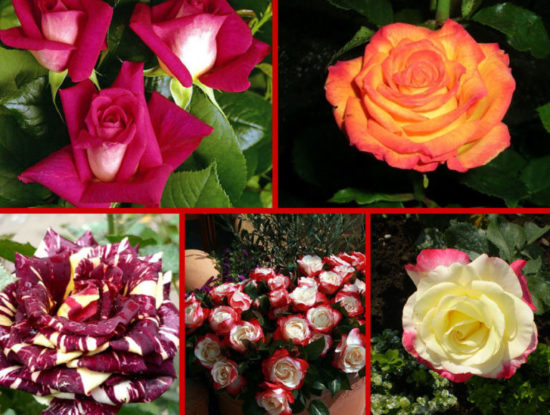
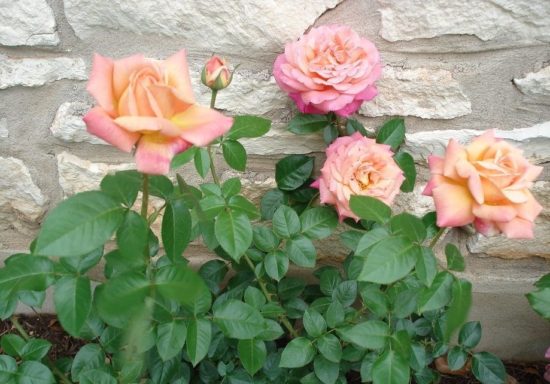

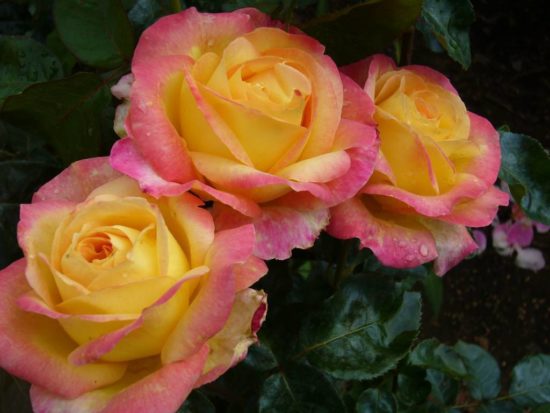
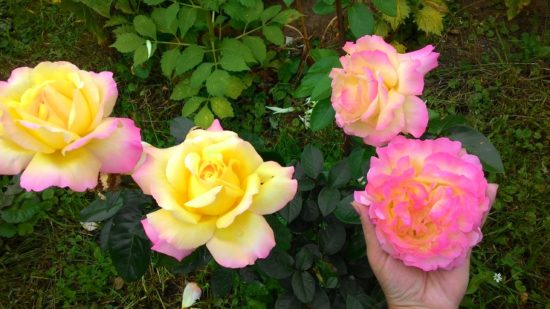
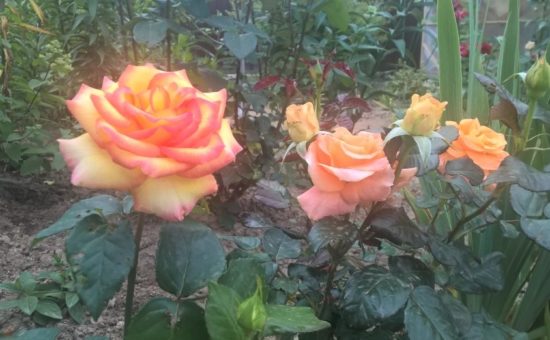
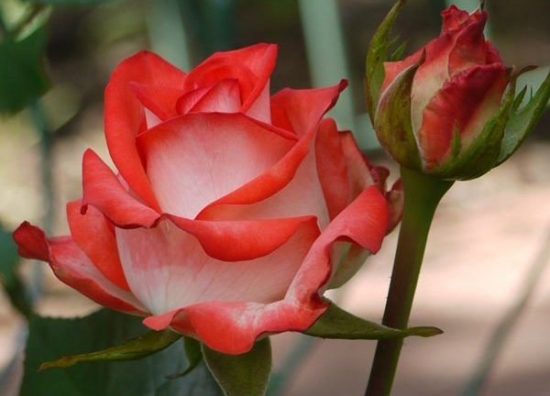
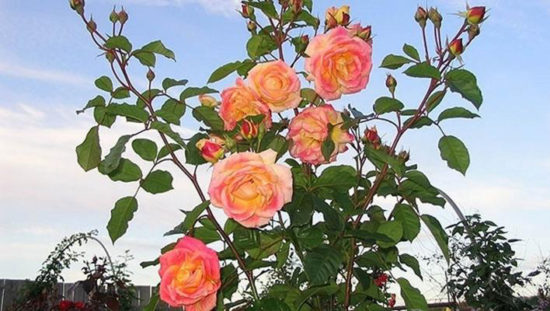
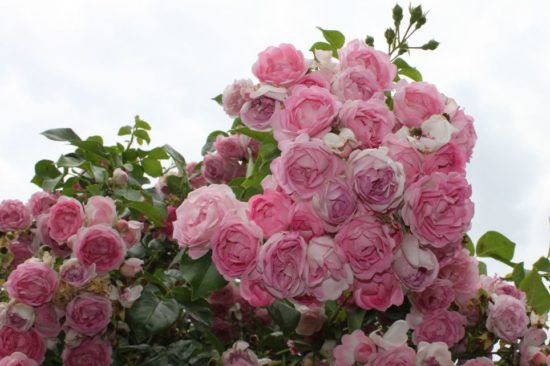
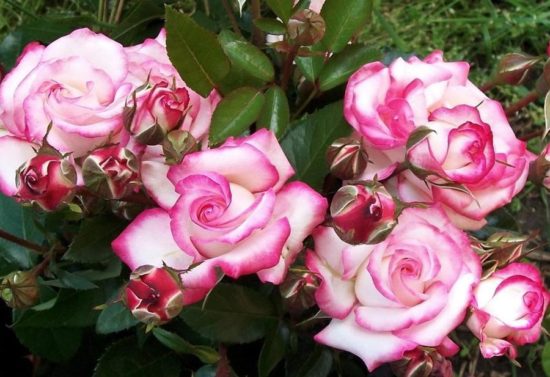
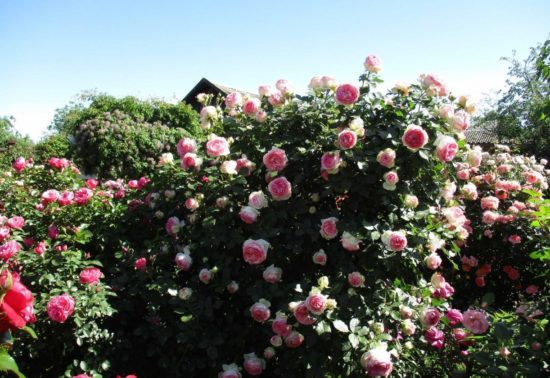
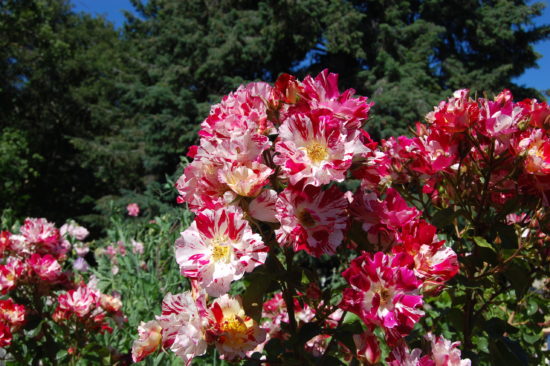

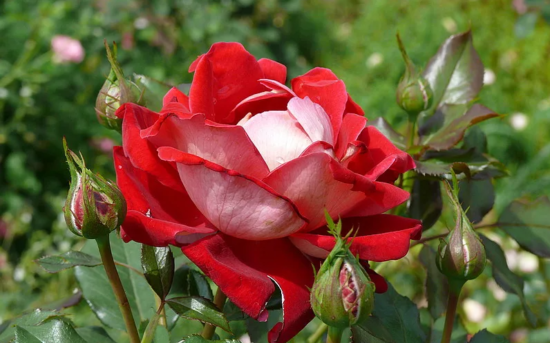
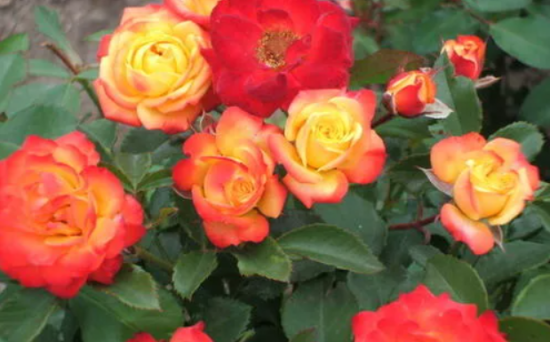
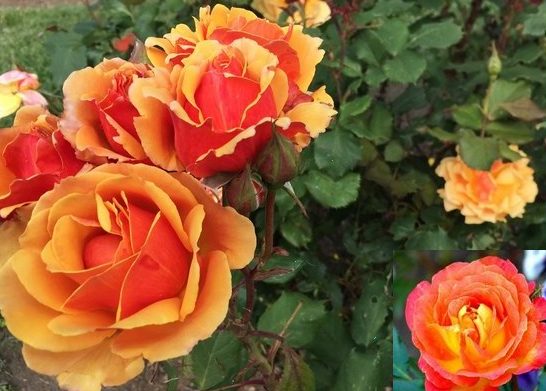
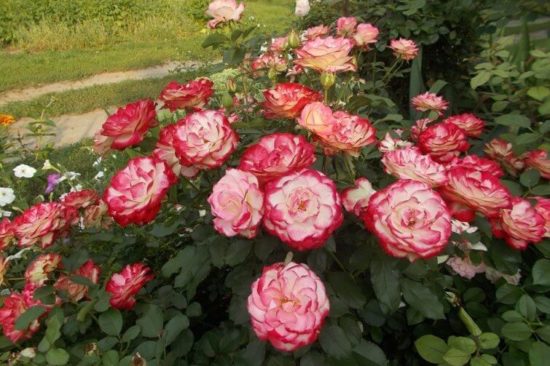
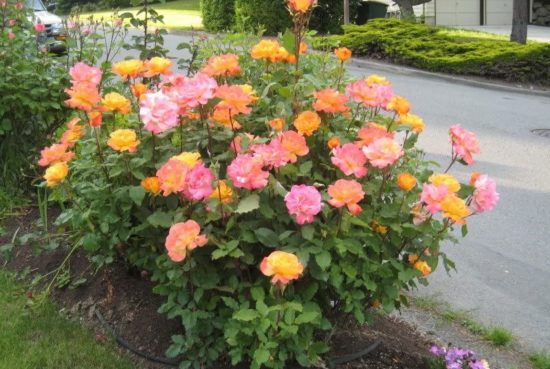


 CUCUMBERS NEVER GET SICK, I'VE BEEN USING ONLY THIS FOR 40 YEARS! I SHARE A SECRET WITH YOU, CUCUMBERS ARE LIKE THE PICTURE!
CUCUMBERS NEVER GET SICK, I'VE BEEN USING ONLY THIS FOR 40 YEARS! I SHARE A SECRET WITH YOU, CUCUMBERS ARE LIKE THE PICTURE! You can dig a bucket of potatoes from each bush. Do you think these are fairy tales? Watch the video
You can dig a bucket of potatoes from each bush. Do you think these are fairy tales? Watch the video
 How our fellow gardeners work in Korea. There is a lot to learn and just fun to watch.
How our fellow gardeners work in Korea. There is a lot to learn and just fun to watch. Eye trainer. The author claims that with daily viewing, vision is restored. They don't charge money for views.
Eye trainer. The author claims that with daily viewing, vision is restored. They don't charge money for views. A 3-ingredient cake recipe in 30 minutes is better than Napoleon. Simple and very tasty.
A 3-ingredient cake recipe in 30 minutes is better than Napoleon. Simple and very tasty. Therapeutic exercises for cervical osteochondrosis. A complete set of exercises.
Therapeutic exercises for cervical osteochondrosis. A complete set of exercises. Which indoor plants match your zodiac sign?
Which indoor plants match your zodiac sign? What about them? Excursion to German dachas.
What about them? Excursion to German dachas.